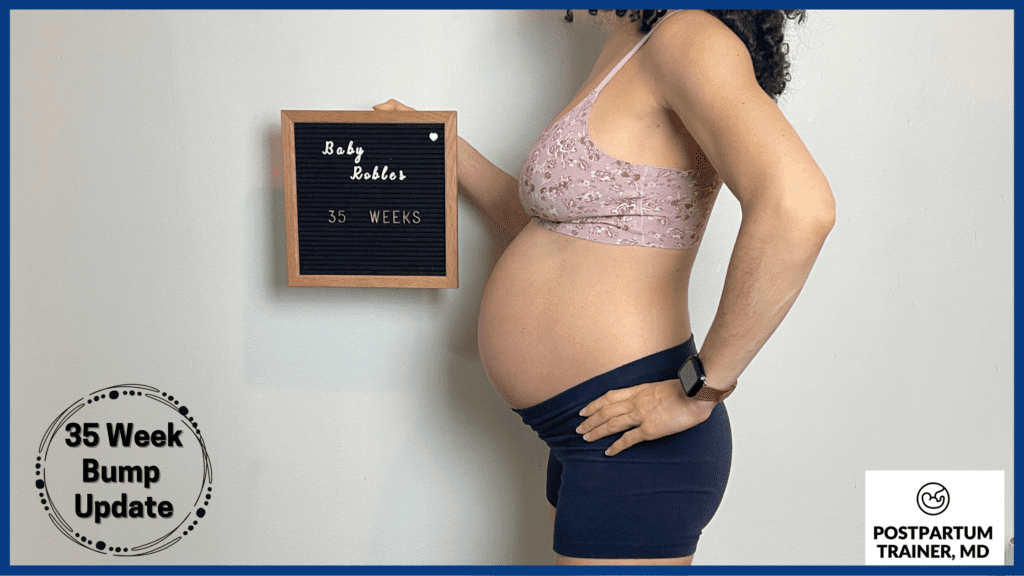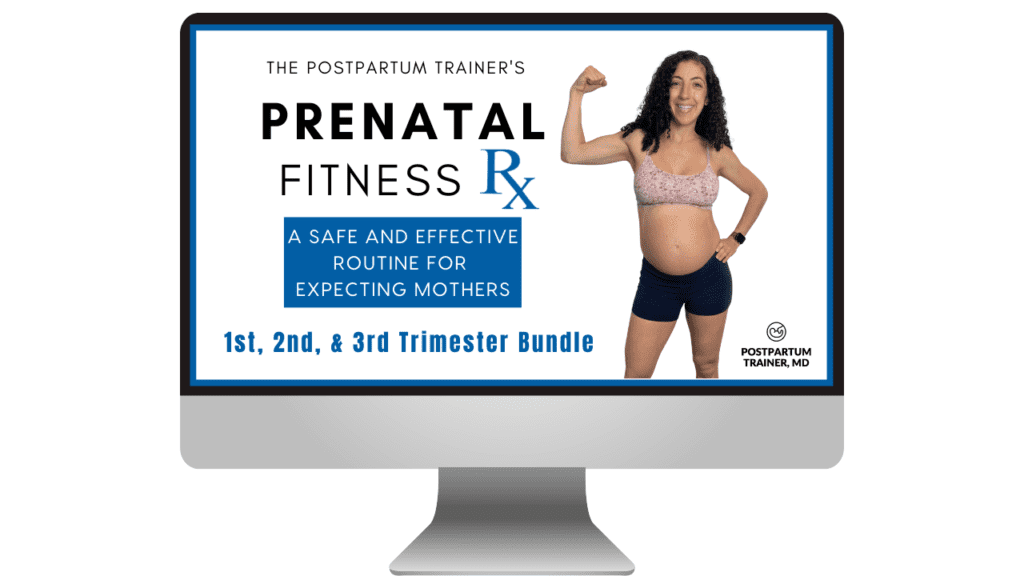My 35 Week Pregnant Belly Picture

Starting Weight: 123lbs
Current Weight: 140lbs
Total Weight Gain: 17lbs
Now let’s go over how my week went and what to expect…
Energy Level: My energy level was great this week. It also helped that I had zero 24 hour calls :). I am extremely grateful that I am still able to get quality sleep.
Pregnancy Symptoms: The main symptom I get on a regular basis is Braxton Hicks contractions, which I am getting used to.
Unfortunately, I do still experience lower extremity leg cramps several nights during the week. It wakes me up and I have to massage my lower legs to improve the symptoms.
Lastly, the frequent urination is frustrating. I have to constantly wake up in the middle of the night to go pee.
Other Physical Changes: No new physical changes. I don’t think my linea nigra will appear. This is quite common in light-skinned women who are pregnant for the first time.
No stretch marks as of yet.
Diet: My diet has not changed much during the third trimester.
I continue to eat a well-balanced diet, drink plenty of water, and take my daily prenatal vitamin.
Here is a short video of my typical diet.
Diet Modifications: No diet modifications this week.
Food Aversions: No food aversions this week.
Food Cravings: No food cravings this week.
Workouts: This week I started a new strength training program focusing on the push, pull, legs protocol. This includes the main strength movements along with some core and pelvic floor exercises.
You can see examples of my entire pregnancy workout in my Prenatal Fitness Prescription.
Here is a video of me benching at an incline using dumbbells.
Modifications to my workout: The only modifications I have made to my workouts are using lighter weights and avoiding being on my back for prolonged periods of time.
*Be sure to speak with your health care provider before doing any physical activity or lifting at this stage of your pregnancy.*
Other Related Questions
How big should a pregnant belly be at 35 weeks?
A pregnant belly at 35 weeks should measure approximately 15 centimeters (+/- 2 centimeters) above your umbilicus or about 35 centimeters (+/- 2 centimeters) from your pelvic bone.
This measurement is known as the fundal height and helps your healthcare provider determine if your baby is growing appropriately.
The way your pregnancy belly looks will be different for every person as there are many factors that will determine where you gain weight.
Some women may have a belly-only pregnancy and gain weight only in the abdomen whereas other women may gain weight throughout the body.
It is important not to compare yourself to other pregnant women!
Here is what my belly looks like at 35 weeks.

How big is a 35 week baby?
A 35-week baby is about 18 inches long and weighs approximately 5.5 lbs. This is equivalent to the size of a pineapple or squash.
Your baby’s growth will continue at about 0.5 lbs per week from this point forward.
What is my baby doing in the womb at 35 weeks?
At 35 weeks, your baby is moving around as much as he can in the cramped uterus. He is also swallowing the amniotic fluid and peeing it back out.
What should you avoid at 35 weeks pregnant?
At 35 weeks pregnant you should avoid:
- Lying flat on your back
- Sustained increase in heart rate
- High risk exercises that increase your risk of falling
- Sexual intercourse if you have been diagnosed with short cervix or placenta previa
- Prolonged travel
You should also avoid excessive caffeine and any other foods that are not safe in pregnancy such as unwashed produce, uncooked deli meats, unpasteurized milk, soft cheeses, high mercury fish, etc.
What are symptoms not to ignore at 35 weeks pregnant?
The following symptoms should not be ignored at 35 weeks:
- Blurry vision
- Severe headache
- Chest pain
- Shortness of breath
- Vaginal bleeding
- Painful uterine contractions
- Leaking fluid from the vagina
- Decreased fetal movements
- Fever or chills
If you do experience any of these symptoms, seek medical attention immediately.
It is also a good idea to review any other symptoms that your provider might want you to look out for that is unique to your situation.
Can your belly drop at 35 weeks?
Yes, it is possible that your belly can drop at 35 weeks. Baby dropping refers to when your baby’s head moves down towards the birth canal and is known as lightening.
Lightening can occur a few weeks prior to delivery however, just because the baby “drops” it does not mean that you will go into labor.
For most pregnant women, the baby doesn’t drop until 39 weeks of gestation.
What are the signs of labor at 35 weeks?
The signs of labor at 35 weeks include:
- Regular painful uterine contractions
- Increased back pressure or pelvic pain with contractions
- Breaking your water
At 35 weeks, your baby is still pre-term. If you experience any signs of preterm labor, you should seek medical attention immediately.
Is giving birth at 35 weeks normal?
Giving birth at 35 weeks is not normal. Babies born at this time are still at an increased risk of developing complications of prematurity.
There are still many organ systems like the lungs and brain that continue to develop until 39 weeks.
If you happen to go into labor at 35 weeks, you may be given 2 doses of steroids, 24 hours apart to help mature your baby’s lungs.
Your baby will also need to go to the neonatal intensive care unit for monitoring.
What can you see in a 35 weeks pregnant ultrasound?
An ultrasound performed at 35 weeks can look at:
- Position of your baby (to determine if the baby is head down)
- How much amniotic fluid is present
- Fetal movements
- Estimated weight of your baby
However, most providers won’t do an ultrasound at this time unless there is a good reason to do one.
Is baby movement painful at 35 weeks?
Your baby’s movements should not be painful, though they can be quite uncomfortable at 35 weeks due to his size.
He now has less room to move around, so when he moves, it is common to feel:
- pressure on your bladder
- lower back discomfort
- sharp shooting pains in your vagina
How many months is 35 weeks?
35 weeks pregnant is 8 months and 3 weeks.
Next week, you will have completed 9 months of pregnancy. Your due date is getting closer!
What position is my baby in at 35 weeks pregnant?
The majority of babies are in the cephalic or head down position at 35 weeks, which is necessary for a normal vaginal birth.
Less than 10% of babies will be in the breech position at this time.
If your baby is still in the breech or transverse position, you may be a candidate for an external cephalic version at 37 weeks of pregnancy.
Anything else I should know?
This week (or next) your provider will check you for Group B Streptococcus (aka GBS).
This is a normal bacteria for pregnant women to have, but it can cause issues for your baby during labor.
Your doctor will also go over any signs of labor you should look out for.
Final Words on The 35th Week of Pregnancy
We are 2 weeks away from being full term, can you believe it?
Do you have your hospital bag and car seat ready for the big day?
Are you continuing to do regular exercise and take care of yourself?
Comment below and let me know what you are doing for the final weeks of your pregnancy.
Also, check back next week for my 36-week update as I enter the last weeks of my pregnancy!
My Other Weekly Updates
- My pregnancy bump at 32 weeks of gestation
- My pregnancy bump at 33 weeks of gestation
- My pregnancy bump at 34 weeks of gestation
Get Four Free Workouts To Help Strengthen Your Pelvic Floor & Heal Your Mommy Tummy!

Brittany Robles, MD, MPH, CPT
Brittany Robles is a full-time OBGYN physician, a NASM certified trainer, and a prenatal and postnatal fitness specialist. She holds a Master of Public Health degree in maternal health with a special interest in exercise and nutrition. She is also the co-author of The White Coat Trainer. Learn more about her here.
Sharing is Caring – Send This To A Mom In Need!
References:
- Weekes AR, Flynn MJ. Engagement of the fetal head in primigravidae and its relationship to duration of gestation and time of onset of labour. Br J Obstet Gynaecol. 1975 Jan;82(1):7-11. doi: 10.1111/j.1471-0528.1975.tb00555.x. PMID: 1138823.
- Gray CJ, Shanahan MM. Breech Presentation. [Updated 2021 Aug 11]. In: StatPearls [Internet]. Treasure Island (FL): StatPearls Publishing; 2022 Jan-. Available from: https://www.ncbi.nlm.nih.gov/books/NBK448063/

